Curiosity vs. Other Mars Missions
October 16, 2014
Mars missions have been all over the news lately. Curiosity’s selfies are all over Twitter. NASA’s MAVEN and India’s MOM have just safely reached orbits around Mars. But not everyone is happy with the return on science.1 So how do science agencies across the globe decide how to spend their limited budgets for missions to the Red Planet?
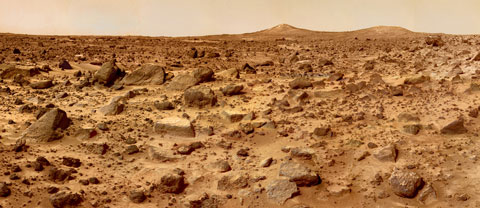
A Martian view taken by NASA's Mars' Pathfinder mission.
Image Credit: NASA/JPL-Caltech
The Costs of Mars Missions
Science projects require funding and lots of it. While India spends a total of $1 billion on its entire space program, MOM only received between $70 to $78 million of that, according to various sources.4-6 But the World Bank has noted that more than a quarter billion people in India live off of $1.25 a day and has questioned the value of spending millions of dollars on orbiting a distant planet.4
According to planetary.org,6 the MAVEN mission cost about $672 million.5-6 The disparity in costs between MAVEN and MOM are due to both scientific and socio-economic differences. The biggest cost differential between MAVEN and MOM stems from their different final orbit around Mars. MAVEN’s final orbit will be more circular, more useful for collecting a lot of data anywhere in its orbit, and more costly to attain. MOM will only be able to collect data when it is going through its closest approach in its very elliptical, and less expensive, orbit.
Meanwhile, NASA’s Curiosity Mars Science Laboratory (MSL) mission has cost about $2.5 billion according to planetary.org.6 The mission included 98 weeks (one Martian year) of data collection. Curiosity landed Aug 5, 2012 and has completed its primary mission. Now the question remains: what should we do next with it, and how much should we spend? Curiosity’s MSL is a pretty sophisticated laboratory that is still in good condition.
Science projects generally have to meet several criteria to be funded or maintain funding. Besides accomplishing good science, the project has to be deemed scientifically valuable, and the dollars going into the project have to be efficiently spent, netting a good return on investment.
The (Science) Return on Investment
Space exploration certainly has strong proponents as evidenced by NASA’s strong funding commitment for great projects like the agency’s various Mars missions. In late May of 2014, many of the Mars missions submitted proposals for additional funding to extend the missions. These proposals were reviewed and the results published.1 Some of the most popular Mars Missions submitted proposals that did not meet NASA’s criteria of good science return.
Below is a summarized list of what various missions proposed to do for an extended mission; how they fared with their proposals and why; and how their revised submissions fared, as detailed in Reference 1. This summary provides a glimpse into how the science world’s peer review process unfolds not only for the endeavor of science, but also for the funding of that endeavor.
The first two Mars missions listed below had proposals with significant scientific return that were deemed worthy of funding. The third had scientific concerns but significant public involvement to keep with limited funds. The last two on the list below required some significant updating because the committee members felt the science return was not high enough.
The $2.5 billion Mars Curiosity (Mars Science Laboratory) is one of the missions that received low grades for its proposed extended mission. A discussion of its impressive scientific capabilities follows this summary. Below are NASA’s evaluations and corresponding letter grades we have assigned for illustrative purposes.
Opportunity (Mars Exploration Rover, MER)
MER’s extended mission proposed surface explorations including “aqueous, environmental, and geologic conditions that constrain past and present habitability, and present climate variability.”
First evaluation: Excellent/Very Good (A)
The review panel felt the proposal and presentation demonstrated how the mission would obtain the information, why it was important that this particular mission obtains the information since other missions could not, and the validity of the proposed investigations. Some concern over software communication might complicate transmission of data, but the risk did not outweigh the scientific gain.
No revisions needed.
Mars Reconnaissance Orbiter (MRO)
MER’s extended mission proposed surface explorations including “aqueous, environmental, and geologic conditions that constraint past and present habitability, and present climate variability.”
First evaluation: Excellent/Very Good (A)
The report notes that the MRO team addressed all questions and that it was significant that 120 papers per year are using the MRO data, many of which are not by MRO team members. The only concern listed is that a spectrometer has lost one of its cryostats and now has no back up, but is still functioning. This is only one of the many tools on MRO.
No revisions needed.
Mars Odyssey (ODY)
The sixth extended mission proposes to move the spacecraft into new orbit to 1) provide information on the distribution of certain components of the Martian atmosphere and how they interact with the surface, 2) generate a global picture of the Martian surface mineralogy, geomorphology, and thermophysical properties, 3) look into radiation environment and its variability as a function of time, and 4) monitor cosmic gamma ray bursts.
First evaluation: Very Good/Good (B-, C+)
The report states that good arguments were made for substantial new science that directly relates to the planetary science division objectives as outlines based on available instrumentation and that some of the proposed tasks only involved data analysis rather than new data collections. However, it was noted that ODY data has been very user friendly with educators and the public and felt it would be detrimental to science productivity if the community were to lose this resource.
Evaluation after revisions: Very good (B)
Based on descoping the gamma ray instruments to maintain focus on planetary science. The panel also noted that over the last three years there has been a decline in published papers related to data obtained and hence funding may soon come to an end.
Mars Express (MEX)
The extended mission had eleven objectives that would investigate Mars’ ionosphere and magnetosphere, in conjunction with MAVEN. It would also continue to image production and validation/calibration activities. Nominal funding would go to the Infrared Mineralogical Mapping Spectrometer to target potential landing sites for the future.
First evaluation: Good/Fair (C-, D+)
The report states that there was inadequate justification of how individuals involved would be involved in analysis to reach goals. The review panel didn’t understand why during 11th year image calibration and validation would still needed since no improvement in images would occur and currently data has only appeared in 4 publications. They also felt that the proposal did not have an effective strategy for prioritization of other missions in view of collaboration with MAVEN since their instruments remain intermittent. It was also noted that there was a lack of communication between MEX team members that hindered progress.
Evaluation after revisions: Very good (B)
Only automated parts of the High Resolution Stereo Camera (HRSC) image processing with occasional spot-checks will be supported and all other HRSC support terminated. Funding for one mission will only pay one salary for a year to assist with coordinating observations from MAVEN.
Curiosity (Mars Science Laboratory - MSL)
The first extended mission proposes to traverse 8 km, visiting 4 different areas that presumably represent different climatic stages in the history of Mars. The team would conduct 8 detailed analyses using the instrument suite on the rover and focus on identifying habitable environments capable of preserving carbon compounds and characterizing the major environmental transition from freshwater deposits to those produced under more acidic conditions. The proposed plan maximizes distance to allow sampling of the four sites.
First evaluation: Very Good/Good (B-, C+)
The report stated that the capabilities of Curiosity provide the only current way to make measurements of carbon, in situ age dating, and ionizing particle flux on the surface, which are minimized in the proposed plan (only 8 samples taken over 2 years, 2 from each site.) The review panel felt this was a poor science return for the investment made. Some of the problems they noted with the proposal are:
• Lack of scientific questions to be answered, testable hypotheses, and proposed measurements and assessments, as well as assessment of uncertainties and limitations.
• Roles for ChemCam and Mastcam (two instruments) were not discussed, nor was the synergistic role of “ground-truthing” in the mission or identifying similar deposits in orbital data for different areas on Mars.
• Argument not convincing for reaching upper-most sulfate location, and the observations in the clays, which may be more relevant to the habitability question, would be cut short with proposed plan.
• No future plan for a 2nd extended mission, although noted that degradation of system is slow.
Evaluation after revisions: Very good/Good (B-, C+)
Suggestions urge NASA HQ to get team focused on maximizing high quality science, by decreasing their objectives of learning about multiple sites to learning more in depth information about fewer sites and doing better to characterize these sites.
Curiosity's Capabilities
Curiosity’s four primary science objectives have been to: 1) assess biological potential, 2) characterize the geology by near surface samples, 3) investigate planetary processes relevant to habitability (e.g. atmospheric cycles), 4) characterize radiation at the surface.8
To reach its objectives, Curiosity is equipped with ten scientific instruments and multiple cameras, some of which are shown in the illustration.8
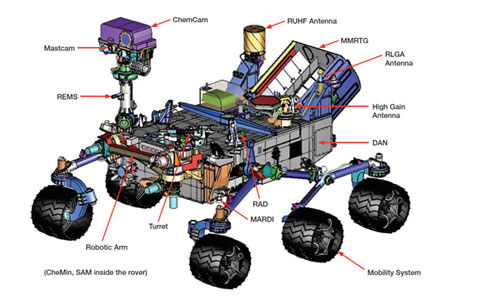
Curiosity and several Mars Science Laboratory instruments.
Image Credit: NASA/JPL-Caltech, Mars Science Laboratory Landing Press Kit8
Engineers designed each unique instrument to gather different information to support the objectives, and some instruments have some overlap of information. The overlap allows scientists to verify the measurements with multiple data sources.
Mastcam
Curiosity has two mast cameras (Mastcam) that act as its eyes. The right camera has a telephoto lens and the left has a medium angle lens. These cameras take snapshots, video, and have filters to do spectral analysis, particularly in near infrared regions. They also have filters that allow for a direct look at the sun to measure the amount of dust particles in the atmosphere.

Left:Mastcam 34: Shorter Focal-Length Eye of Mast Camera Pair for Mars Rover.
Right:Mastcam 100: Longer Focal-Length Eye of Mast Camera Pair for Mars Rover.
Image Credit: NASA/JPL-Caltech
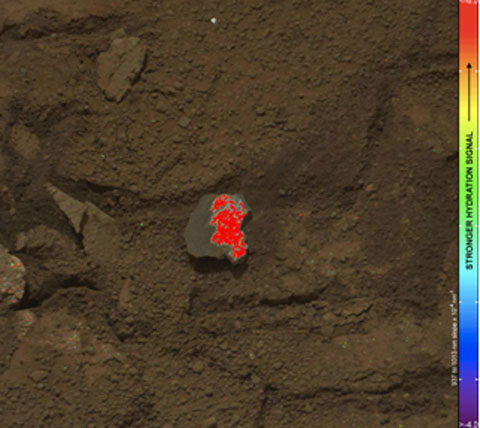
An image of a hydration map based on Mastcam’s spectral analysis.
Image Credit: NASA/JPL-Caltech/MSSS/ASU
ChemCam
ChemCam uses a laser to completely ionize (separate all electrons from a nucleus creating a plasma) a “pin-sized” amount of a substance up to 7 meters away. A telescope views and records the event and sends the spectrum of light emitted by the substance to three spectrometers inside curiosity that measure the intensity of each wavelength observed over a range between UV and IR.
Because each element has its own distinctive set of emission wavelengths, the spectrometers can determine the substances present such as sodium, magnesium, aluminum, silicon, etc. NASA uses ChemCam to image particle size, particle distribution, and chemical composition.
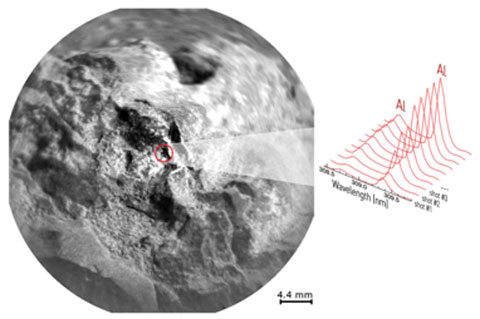
ChemCam information from a rock on Mars.
Image Credit: NASA/JPL-Caltech
Alpha Particle X-Ray Spectrometer (APXS)
This instrument can identify chemical composition in rocks and soils and determine the natural abundance of each element and isotope. APXS emits ionizing radiation (alpha particles and X-rays) from a radioactive source of curium. This emitted radiation bombards the sample of interest and the sample then emits its own characteristic X-ray spectrum, which is measured. From this information the relative amounts of each element is determined.
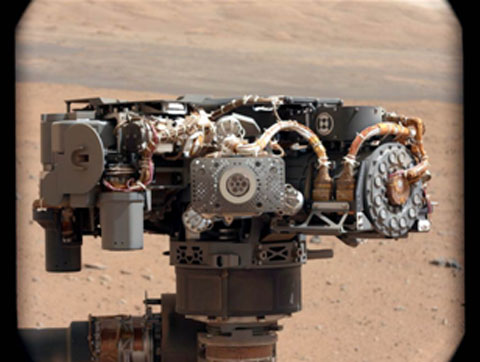
A photo taken on Mars of Curiosity’s Alpha Particle X-Ray Spectrometer (APXS).
Image Credit: NASA/JPL-Caltech/MSSS
Mars Hand Lens Imager (MAHLI)
This instrument is at the end of one of Curiosity’s arms and is a focusable color camera with a macro lens and autofocus. Geologists look at rocks. They look at the color, shapes, cleavage planes, grain size, and layering scale. This instrument allows the close up visuals needed to provide information about the rocks and give clues to weathering and erosion. MAHLI also has some light emitting diodes that glow in the UV which allow scientists to view the rock samples fluorescence.
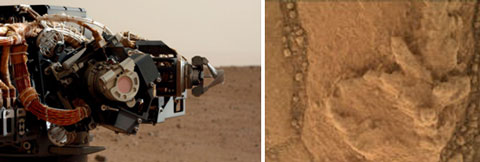
A photo taken on Mars of Curiosity’s Mars Hand Held Lens Imager (MAHLI) and a picture it took.
Image Credit: NASA/JPL-Caltech
Chemistry and Mineralogy (CheMin)
This instrument uses X-ray diffraction to determine the mineral content in crushed samples. To do this it shines a beam of X-rays at the sample and detects how they are scattered. The scattering angle gives information about the atomic crystalline structure. It also uses X-Ray fluorescence to detail the ratios of the elements composing the material. Each ChemMin analysis requires 10 hours of data accumulation.
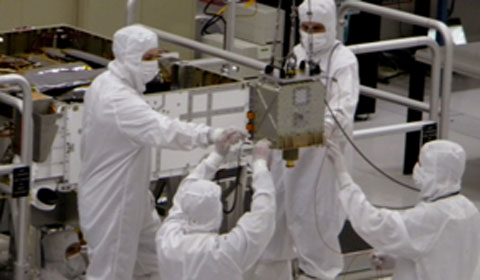
The Chemistry and Mineralogy (CheMin) instrument being installed.
Image Credit: NASA/JPL-Caltech
Sample Analysis at Mars (SAM)
This instrument examines gases from the atmosphere and from powdered samples put in ovens that heat up to 1800˚ F and solvents. It contains a mass spectrometer to identify the gases by their molecular weight.
It also has a tunable laser spectrometer that looks how specific frequencies of light are absorbed to determine types and amounts of gases present as well as the ratios of different isotopes present. SAM also has a gas chromatograph that separates the different gases and detects organic compounds. SAM has the ability to detect smaller quantities of a substance than any other instrument on Curiosity.
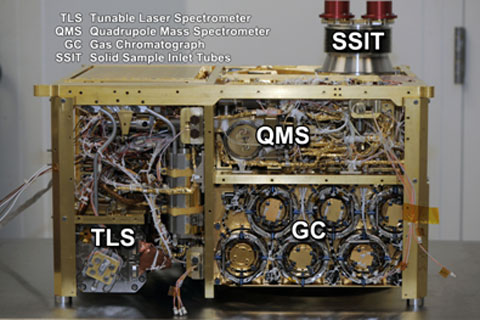
Sample Analysis at Mars Instrument, Side Panels Off (Annotated)
Image Credit: NASA/JPL-Caltech
Rover Environmental Monitoring Station (REMS)
REMS is a weather station. It records wind speed, wind direction, air pressure, relative humidity, air temperature, ground temperature, and UV radiation every hour.
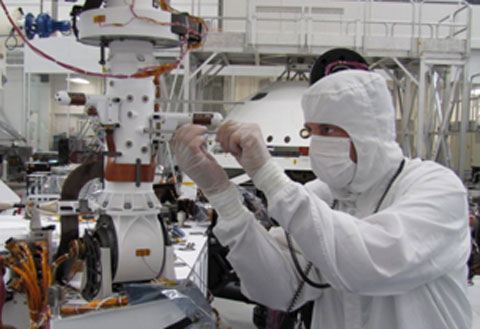
The Rover Environmental Monitoring Station (REMS) is Curiosity’s weather station.
Image Credit: NASA/JPL-Caltech
Radiation Assessment Detector (RAD)
RAD measures high-energy atomic and sub-atomic particles that form the naturally occurring background radiation on the planet. Much of the radiation comes from the Sun or distant supernova. This information informs hypotheses regarding how habitable Mars may have been or could be.
Dynamic Albedo of Neutrons (DAN)
This instrument looks for water about 50 cm (20 inches) below Curiosity. It shoots neutrons into the ground and measures which way they are scattered and how long they take to get back. When the neutrons bounce off of hydrogen, they do so with a specific decrease of energy that provides information about the amount and location of hydrogen under the surface.
DAN can also use passive cosmic radiation as a source of neutrons to do its measurements. The information gathered will add to nuclear testing for hydrogen from orbital instruments and it will help determine where Curiosity should dig in and investigate more.
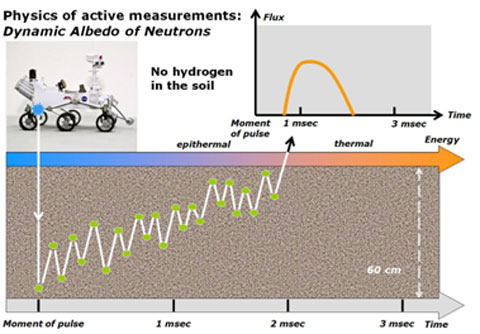
Image Credit: NASA/JPL-Caltech/Russian Space Research Institute
Mars Descent Imager (MARDI)
MARDI video taped Curiosity’s decent to Mars. It also provided information about Mars’ atmosphere during its decent. This information combined with information from Curiosity’s sensors provide insight for future landings on Mars. MARDI also can image the ground beneath Curiosity for geologic mapping and tracking. The one minute video of Curiosity’s descent through the Martian atmosphere is available online at NASA Jet Propulsion Laboratory’s website linked here.
MSL Entry, Descent, and Landing Instrument (MEDLI) Suite
This suite consists of seven pressure sensors, multiple temperatures sensors, velocity sensors that detect changes in speed and direction. These sensors help in understanding atmospheric information, turbulence during landing, detailed information on Curiosity’s heat shield, and will aide in the design of future missions.
Curiosity’s Mars Science Laboratory is equipped with instruments that many experimentalists would love to have. The mission truly represents a major feat of science and engineering, and now that its first mission is over and everything is still functioning well, it should continue to be utilized to its fullest. This is why the review panel was concerned with the suggestions for the first extended mission.
For the cost of the instrumentation, they believed the scientific information should be far more in depth, utilizing all of curiosity’s instruments to their fullest rather than utilizing the vehicle carrying the instruments to the fullest.
The result of Curiosity visiting fewer sites rather than going to all four sites proposed does not mean that it will never go visit the other sites. Perhaps those will be for its second extended mission. It is likely that Curiosity and its laboratory will be functioning for a number of years.
References and Resources
1. NASA Planetary Senior Review panel Reporthttp://www.lpi.usra.edu/pss/sep2014/Senior-Review-2014-Report.pdf
2. Howell, E., NASA Curiousity Rover Missing ‘Scientific Focus and Detail’ in Mars Mission: Review, 4 September 2014
3. Neuman, S., NASA: MAVEN Spacecraft Safely Circling Mars, NPR 22 September 2014
4. McCarthy, J., India’s Orbiter to Join NASA’s Maven Around Mars – On a Shoestring, NPR, 22 September 2014.
5. Neuman, S., Success! India’s First Mars Probe Is in Orbit and Working, NPR 24 September, 2014
6. Drier, C., The Planetary Society, blog (2012)
http://www.planetary.org/blogs/casey-dreier/20120809-curiosity-comes-cheap.html
7. Mars Science Laboratory, Curiosity Rover website
http://mars.jpl.nasa.gov/msl/
8. Mars Science Laboratory Landing, Press Kit
http://mars.nasa.gov/msl/news/pdfs/MSLLanding.pdf
—H.M. Doss














